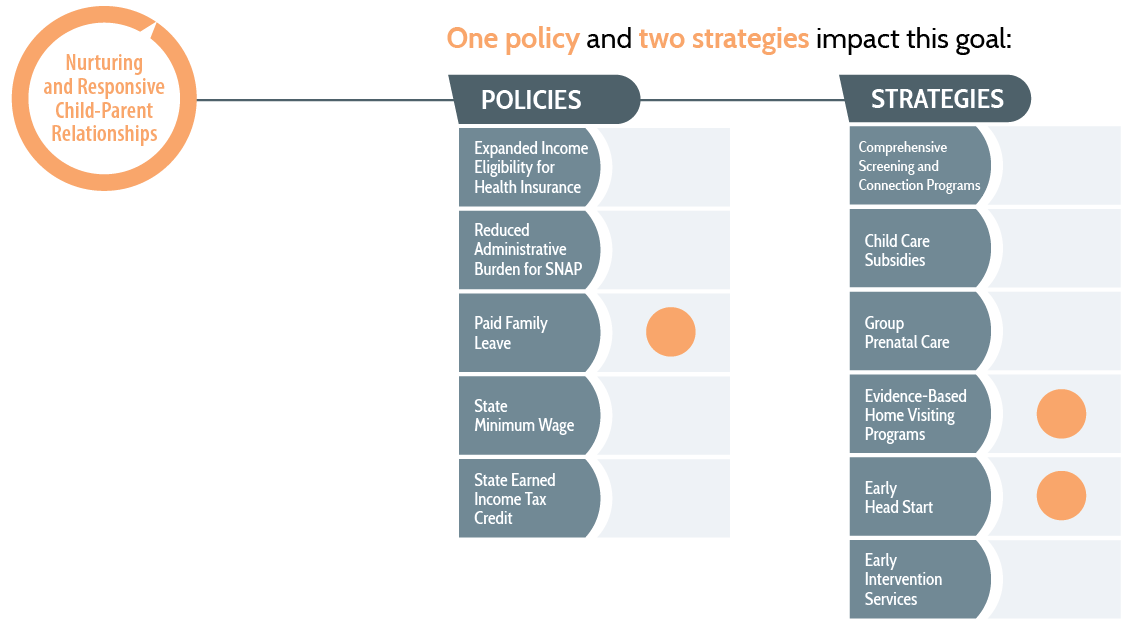
Effective policies and strategies to impact this goal include:
Children experience warm, nurturing, stimulating interactions with their parents that promote healthy development.

WHY ARE NURTURING CHILD-PARENT RELATIONSHIPS AN IMPORTANT PRENATAL-TO-3 GOAL?
Stable, responsive relationships with caregivers during the earliest months and years of a child’s life are key to long-term healthy development. Yet those critical early years also can be stressful for parents, who may themselves struggle to cope and to connect with their children. The developing brain depends on secure attachments and serve-and-return interactions, in which adults reliably and appropriately respond to a child’s cries, babbles, and other bids for connection. These interactions shape brain architecture, both providing the positive stimulation children need for typical development and acting as a buffer to stress, protecting the developmental process from disruption.1
Persistent absence of warm, reciprocal interactions increases the likelihood that a child will experience poor outcomes for health and wellbeing.2 Neglect—which accounts for the majority of child maltreatment cases—is associated with a particularly wide range of mental and physical health consequences, including behavioral disorders, interpersonal difficulties, chronic illness, and poor school achievement.3 When families experience adversity related to economic hardship, limited education, or discrimination, the stress can interfere with parent-child interactions and perpetuate socioeconomic, racial, and ethnic disparities in children’s health risks.4 Many of the stresses brought on by COVID-19—including economic uncertainty and job loss, confinement in crowded settings, and lack of access to support networks—can increase the risk, to both women and children, of exposure to violence and can further exacerbate underlying disparities.5
Measuring the quality of children’s interactions with adults is not easy, nor are data in this area abundant. However, some measures from available state-level data do capture this critical component of children’s development so that states can assess how parents and young children are faring. Next, we provide an overview of these measures—parents’ daily reading with a child, daily nurturing behaviors, and self-reports on coping with the demands of parenting. States should use these outcomes to track progress toward improving young children’s opportunities for engaging with parents in the warm, stimulating interactions they need. States also can implement the policies and strategies, reviewed in these sections, that have proven successful in achieving this goal.
HOW ARE STATES CURRENTLY MEETING THIS PRENATAL-TO-3 GOAL?
Three outcome measures illustrate parents’ nurturing interactions with their infants and toddlers: (1) daily reading, (2) daily nurturing behaviors, and (3) parenting stress. These outcomes vary considerably across states, and daily reading and nurturing vary by race and ethnicity as well.
All three outcome measures were calculated intentionally in the negative direction to demonstrate where states have room for improvement and to help states prioritize the PN-3 policy goals. Out of 51 states, the state lagging furthest behind ranks 51st, and the leading state ranks first. The median state indicates that half of states have outcomes that measure better than that state, whereas half of states have outcomes that are worse. Importantly, the “leading” state on a given outcome does not necessarily indicate a target for all other states to strive toward; even in the states with the best outcomes, many children and families are struggling.
OUTCOME MEASURE: LACK OF DAILY READING
% children under age 3 not read to daily
Median state value: 60.5%
Daily reading to a child stimulates brain development and fosters child-parent bonding. In the US, more than 3 out of 5 children under age 3 are not read to daily. In the five leading states, approximately 48% to 52% of children lack daily reading, but in the five lagging states, over 70% of infants and toddlers are not read to daily. Black and Hispanic children are nearly 50% more likely than White children not to be read to daily.

Source: 2018-2020 National Survey of Children’s Health (NSCH).
OUTCOME MEASURE: LACK OF DAILY NURTURING BEHAVIORS
% children under age 3 not nurtured daily
Median state value: 41.5%
Singing songs, telling stories, and playing games like peekaboo are effective nurturing behaviors that stimulate brain development and promote child-parent attachment. In the US, more than 2 out of 5 children under age 3 do not receive these nurturing interactions on a daily basis. In the five lagging states, about half of babies do not have these nurturing interactions, but up to one-third of babies in the five leading states do not experience this nurturing either. About half of Black and Hispanic babies do not experience nurturing behaviors daily, compared to slightly over one-third of White babies.

Source: 2018-2020 National Survey of Children’s Health (NSCH).
OUTCOME MEASURE: PARENTING STRESS
% children under age 3 whose parent reports they are not coping very well
Median state value: 31.4%
Parenting can be challenging, and parents who are overwhelmed by the challenges are less likely to engage with their children and foster secure attachments and optimal brain development. Over 30% of all children under age 3 live with parents who struggle to cope with the demands of parenting, but the numbers are nearly twice as high in the five lagging states compared to the five leading states. This outcome does not vary substantially by race and ethnicity.

Source: 2018-2020 National Survey of Children’s Health (NSCH).
For additional information regarding calculation details, data quality, and source data please refer to Methods and Sources.
For more information on outcomes by goal, including by race and ethnicity and state, see the 2022 Prenatal-to-3 State Policy Roadmap section on outcomes across the US.
WHAT ARE THE MOST EFFECTIVE POLICIES AND STRATEGIES TO IMPACT NURTURING CHILD-PARENT RELATIONSHIPS?
Based on comprehensive reviews of the most rigorous evidence available, the Prenatal-to-3 Policy Impact Center identified 11 effective solutions that foster the nurturing environments infants and toddlers need. For each of the five policies, the evidence points to a specific policy lever that states can implement to impact outcomes. For the six strategies, the evidence clearly links the strategy to PN-3 outcomes, but the current evidence base does not provide clear guidance on how states should implement each strategy to positively impact outcomes. Three policies and strategies have demonstrated effectiveness at improving child-parent relationships.

For more information on the impact of state-level policies and strategies in the prenatal-to-3 period, search the Prenatal-to-3 Policy Clearinghouse for an ongoing inventory of rigorous evidence reviews. To learn more about the impact of effective policies and strategies on the eight prenatal-to-3 policy goals, see the Prenatal-to-3 State Policy Roadmap.
SOURCES
- Center on the Developing Child. (n.d.) Serve and return. https://developingchild.harvard.edu/science/key-concepts/serve-and-return/#:~:text=Serve%20and%20return%20interactions%20shape,of%20communication%20and%20social%20skills
- Center on the Developing Child. (n.d.) Neglect. https://developingchild.harvard.edu/science/deep-dives/neglect/
- Center on the Developing Child. (n.d.) InBrief: The science of neglect. https://developingchild.harvard.edu/resources/inbrief-the-science-of-neglect-video/
- Shonkoff, J.P. (2014). A healthy start before and after birth: Applying the biology of adversity to build the capabilities of caregivers. In K. McCartney, H., Yoshikawa, & L. B. Forcier (Eds.), Improving the odds for America’s children (pp. 28-39). Harvard Education Press.
- Peterman, A., Potts, A., O’Donnell, M., Thompson, K., Shah, N., Oertelt-Prigione, S., & van Gelder, N. (2020). Pandemics and violence against women and children (Working Paper 528). Center for Global Development. https://www.cgdev.org/publication/pandemics-and-violence-against-women-and-children
